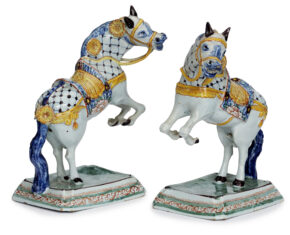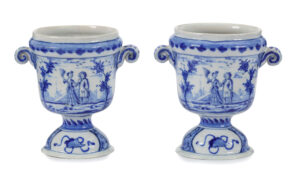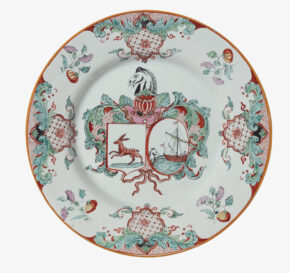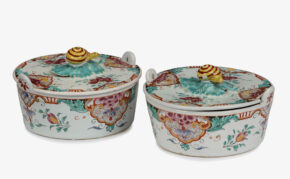![]()
Images on this website are licensed under a
Creative Commons Attribution-NoDerivs 3.0 Unported License.
OBJECT
D2440. Pair of Blue and White Wine Cisterns
Delft, circa 1760
Modeled as a ‘Bobbejak’ (portly man) with wide open mouth, one wearing a dark manganese tricorn hat, a wide ruffled collar, and a blue-buttoned jacket with diamond shaped compartments decorated with demi-flowers alternated with dots, over a shirt with cuffs, the dark blue ankle-length trousers with flower heads and circles in white, highlighted with light blue, revealing his dark manganese shoes, his manganese hair with two rows of tight curls over his ears and extending into a long braid forming the handle affixed to his waist at the back, his hands placed on his ample belly, and seated on a blue marbleized rock applied at the front between his shins with a blue rocaille cartouche with an aperture for a spout, his counterpart modeled in the exact same way, but wearing a jacket with flower heads overlapping the diamond shapes, his sleeves adorned with stars, the blue trousers with a similar, but slightly different floral pattern.
DIMENSIONS
Height: 34.5 cm. (13.6 in.)
PROVENANCE
French Private Collection, Paris, 2023 (Provenance+)
NOTE
Figural cisterns of various male and female models, probably intended for beer, gin or wine, are referred to in Dutch as ‘Bobbejakken’, whereas their French derivatives are called ‘pots-Jacquot’ or ‘pots-Jacqueline’, and the English variations are called ʻToby jugsʼ (a name possibly derived from the jovial intoxicated Sir Toby Belch in William Shakespeareʼs play, Twelfth Night, but more likely from the notorious eighteenth- century Yorkshire toper, Henry Elwes, who was known as ʻToby Fillpotʼ (or Philpot), and who inspired a popular English drinking song, ʻThe Brown Jugʼ, as well as a print published in 1761 by Carver and Bowles, London, which paid tribute to the then- infamous “Toby Fillpotˮ). Some of the Dutch Delft examples may be based on eighteenth- or nineteenth- century penny prints of the type depicting ‘Trijn en Hans Altijddorstʼ (ʻTrijn and Hans Always-thirstyʼ), published by J. B. Ulrich, Rotterdam, circa 1820-50, and illustrated ibid., p. 102, no. 67, fig. 1.
SIMILAR EXAMPLES
An identical white figural cistern, along with a Chinese export porcelain polychrome example for which it served as the model, is illustrated by D. Howard and John Ayers, China for the West, Vol. II (London 1978), p. 620, no. 650, where the authors comment that examples of the model and its female companion, known as ‘Bonhomme’ and ‘Jacqueline’, “were produced in Delft, at Brussels in Belgium, and in France at Rouen… The full significance of the plump figure remains unexplained, yet its origins can be at least partially guessed at, for Bacchic figures seated on barrels used as spirit flasks were also typical of Delft and other north European potteries of this time [the mid eighteenth century] (they were even copied in Japanese porcelain), and the development of these can be traced back to the time of the Renaissance.”
A petit feu polychrome cistern of this model, possibly intended as a character from the Commedia dell’Arte or the Comédie Française, is illustrated in Aronson 2010, pp. 128 and 129, no. 75. Other ‘grand feu’ polychrome cisterns of the model, though with variations in the hat and with a loop handle rather than the rare braided queue handle on the present and aforementioned petit feu examples, are illustrated in Lunsingh Scheurleer 1984, p. 228, ill. 125; Aronson 1996, ill. 15; Aronson 2003, p. 60, no. 59; and Aronson 2007, p. 55, no. 40. Another from the Aronson 1996 collection, and a Flemish terracotta counterpart dated 1744, which could have been the source for the model, are illustrated by J. Estié in “Beelden, trompe l’oeil en excentrieke objecten, De Hollande modellen”, in Lahaussois 2008, p. 177, ills. 3 and 4.
Besides these male comedian figures, Delft figural cisterns were modeled as drinking men (Bacchus) on barrels (previously cited), as pairs of jolly couples, and in a larger size as pairs of elegant men and women, examples of which are illustrated in Aronson 2008, p. 116, no. 87, and p. 119, no. 90; and in Aronson 2009, p. 103, no. 67, and p. 106, no. 69.









